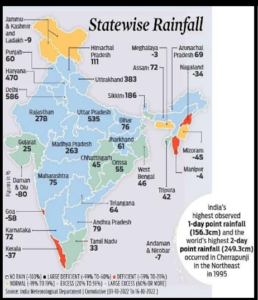INDIA’S EXTREME RAINFALL CORRIDOR
Monsoon Dynamics and Global Warming:
- Global warming affects all aspects of the Indian monsoon, leading to a decreasing trend in total seasonal rainfall over seven decades.
- Changes are observed in the duration and intensity of dry and wet spells.
Source: Indian Express
Challenges in Forecasting Extreme Rain:
- While the India Meteorological Department (IMD) has made progress in forecasting extremes, multiple factors still contribute to unpredictable heavy rain events.
- Current reliance on El Nino and La Nina phenomena provides accurate forecasts only 60% of the time.
Large-Scale Extreme Rainfall Corridor:
- A recent study reveals a consistent ‘highway’ for large-scale extreme rainfall events, spanning from West Bengal and Odisha to Gujarat and Rajasthan.
- Surprisingly, this corridor has remained unchanged from 1901 to 2019, offering potential improvements in process understanding for better predictions.
Implications for Monsoon Stability and Forecasts:
- Network analysis of rainfall nodes shows a stable “highway” where extreme events synchronously occur for over a century.
- Despite global warming, this synchronicity remains, suggesting potential for more accurate forecasts without the need for increased model resolution and computational cost.
- The study highlights the importance of understanding the dynamics of synchronisation for risk reduction in various sectors, leveraging India’s robust modelling capacity.
Note: The findings suggest a stable pattern in extreme rainfall events despite climate changes, providing an opportunity for improved forecasts and risk reduction.

 Source: Indian Express
Source: Indian Express

